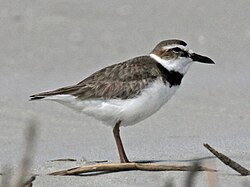Wilson plover
| Wilson plover | ||||||||||
|---|---|---|---|---|---|---|---|---|---|---|

Wilson plover on Sanibel Island , Florida |
||||||||||
| Systematics | ||||||||||
|
||||||||||
| Scientific name | ||||||||||
| Charadrius wilsonia | ||||||||||
| Ord , 1814 |
The Wilson plover ( Charadrius wilsonia ), also known as the thick-billed plover , is a small plover .
It is a wader that breeds north on both coasts of America from the equator . Its range extends north and includes much of the US east coast and the Pacific coast of Mexico in the west.


It is a partial puller . The birds leave the United States, with the exception of Florida , to winter in Brazil or the south. Some Mexican birds migrate to Peru in winter . Brazil has a small year-round population that was recognized as a new brasiliensis subspecies in 2008 . In 2012, this was found to be a junior synonym and the correct name for the subspecies crassirostris . As a result, a subspecies of the ringed plover had to be renamed.
This plover, which only lives near the coast, nests on sandy beaches or bare sandbanks .
The Wilson plover is one of the small plovers at 17–20 cm. The top of the adult bird is predominantly dark gray with a short white wing stripe and white flanks. The underside is white except for a chest band, the white throat merges into a conspicuous white neck ring, the legs are pink, lighter when brooding. The dark beak is large and massive for a plover of this size. The call is a high-pitched faint whistle.
The male in the breeding plumage has a black chest band, black reins and a black front upper head as well as a reddish brown face mask. Females and males in plain dress have similar plumage, but the black of the brooding male is replaced by brown or reddish brown. Non-breeders have a grayer tint on the head and chest bands. Immature birds resemble the female, but the chest ligament is often incomplete.
Wilson plovers forage on beaches and slowly move across the beach . They prefer crabs but also eat insects and sea worms. The species was named in 1814 by George Ord after his friend, the Scottish-American ornithologist Alexander Wilson .
Individual evidence
- ^ Rolf Grantsau, Pedro C. Lima: Uma nova subespécie de Charadrius wilsonia (Aves, Charadriiformes) para o Brasil . In: Atualidades Ornitológicas . 142, 2008, pp. 4-5.
- ^ CJ Carlos, JF. Voisin: Charadrius wilsonia brasiliensis Grantsau & Lima, 2008, is a junior synonym of Charadrius crassirostris Spix, 1825 . In: Bulletin of the British Ornithologists' Club . 131, No. 1, 2012, pp. 165-170.
- ^ CJ Carlos, S. Roselaar, JF. Voisin: A replacement name for Charadrius leschenaultii crassirostris (Severtzov, 1873), a subspecies of Greater Sand Plover . In: Bulletin of the British Ornithologists' Club . 132, No. 1, 2012, pp. 63-65.